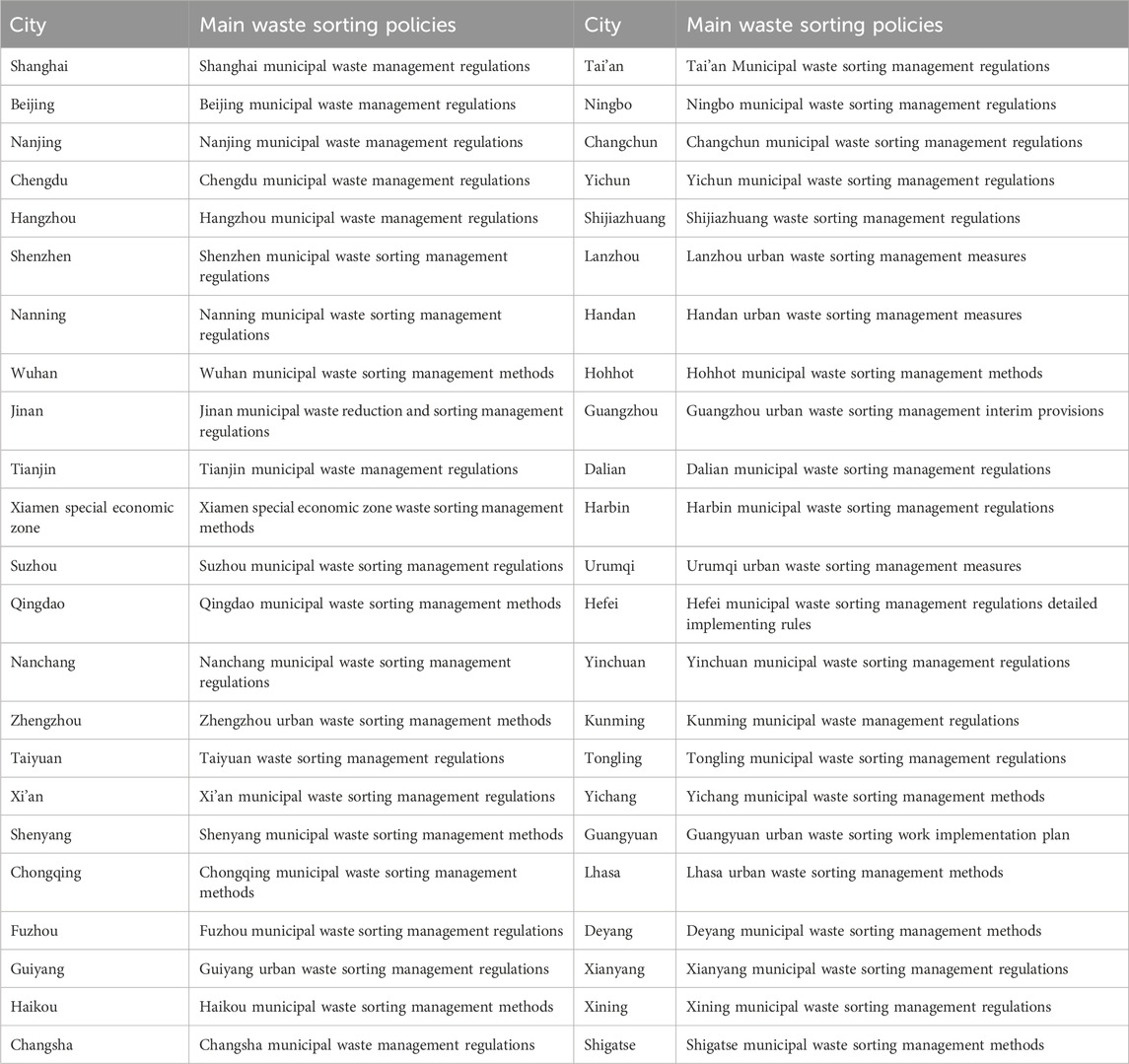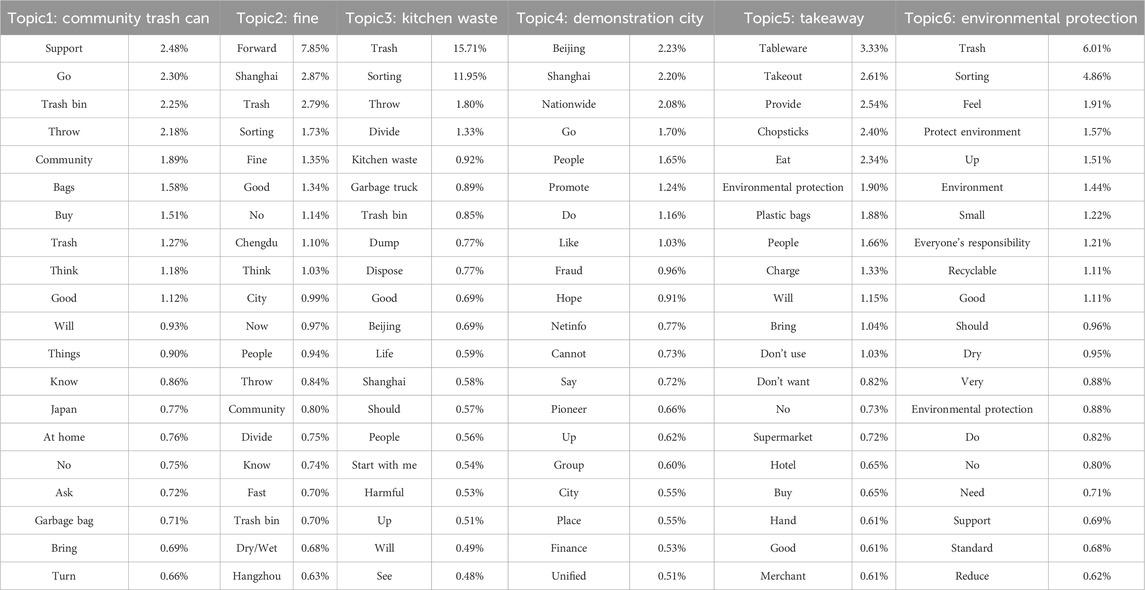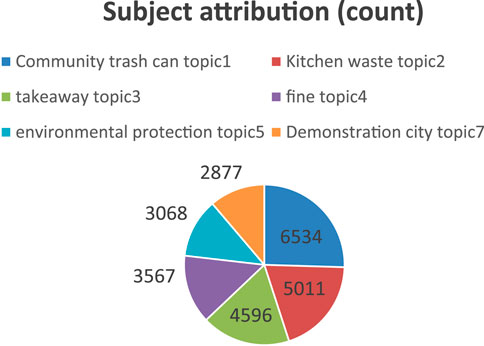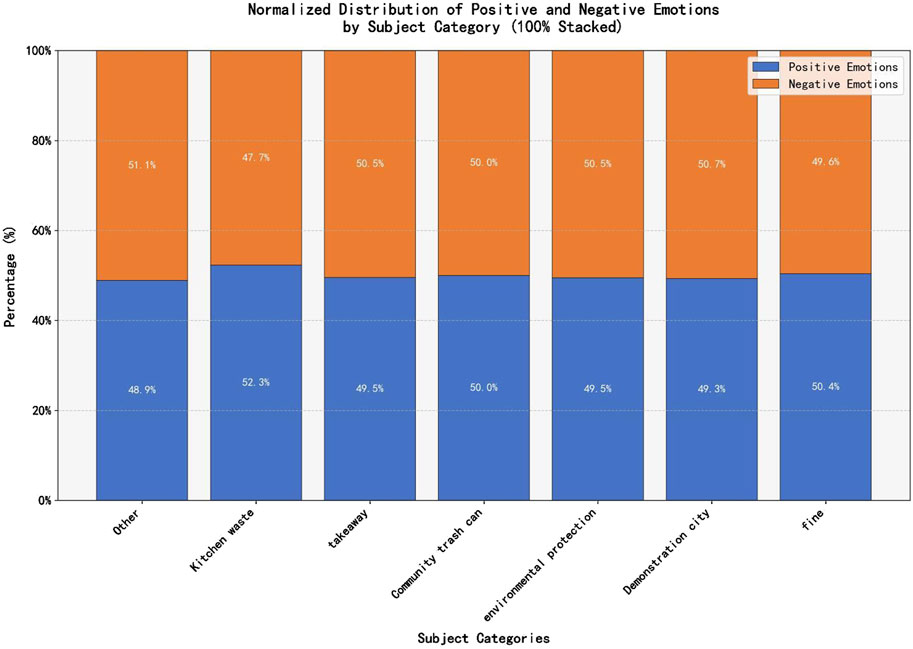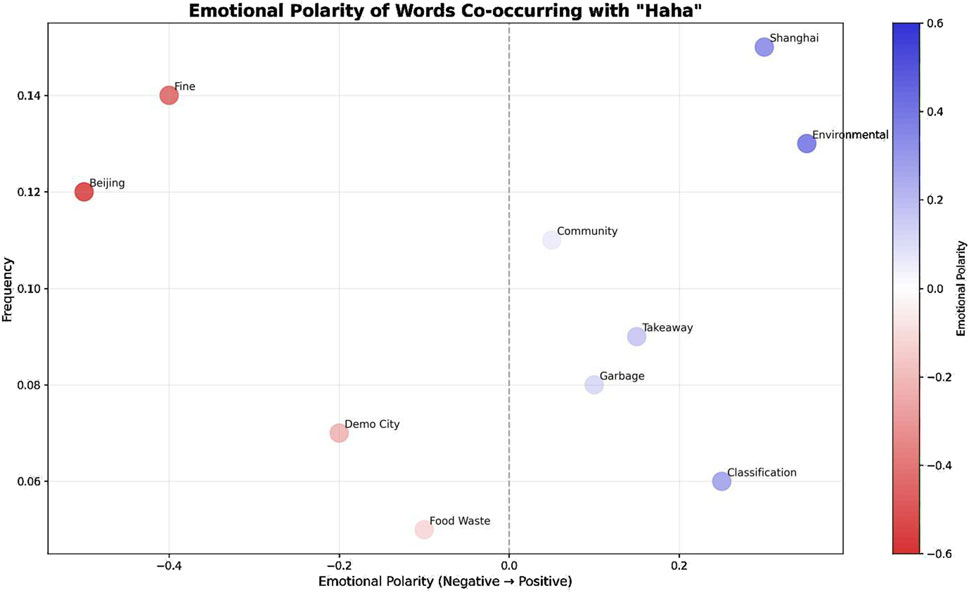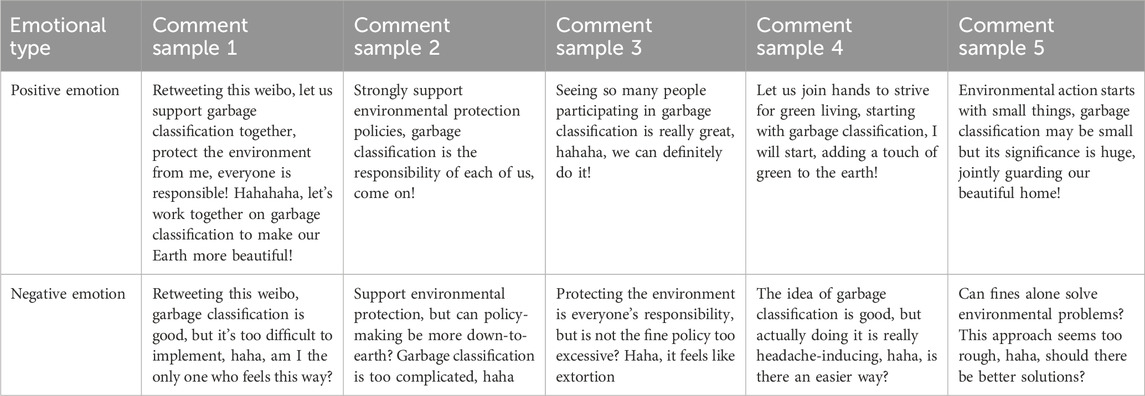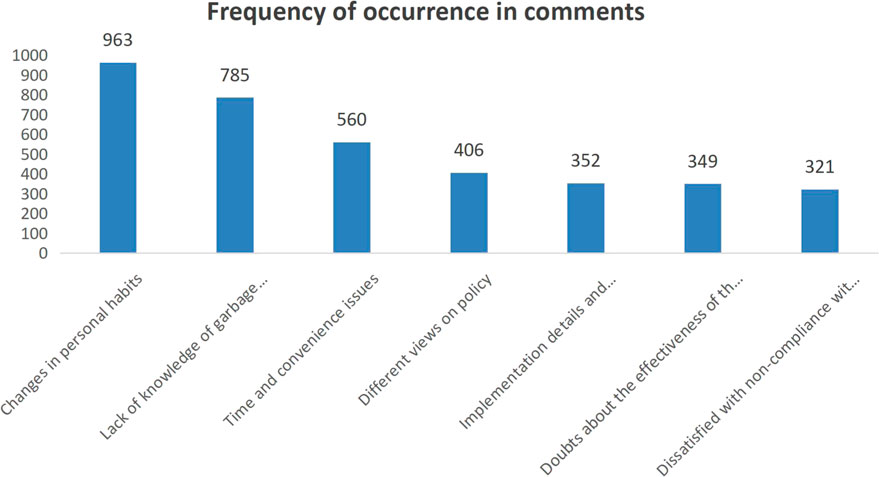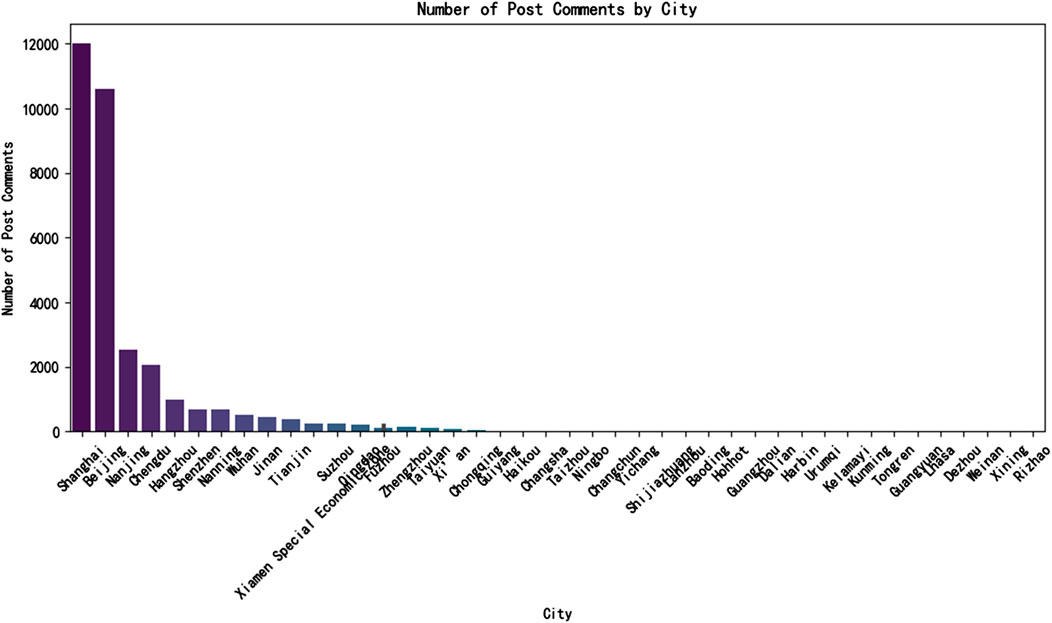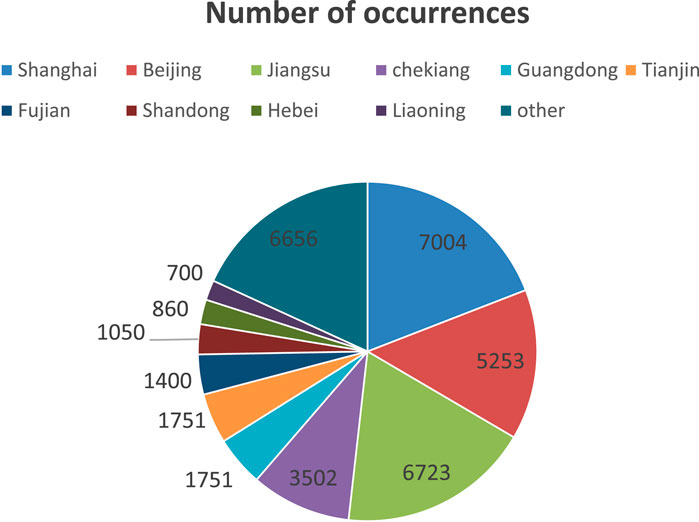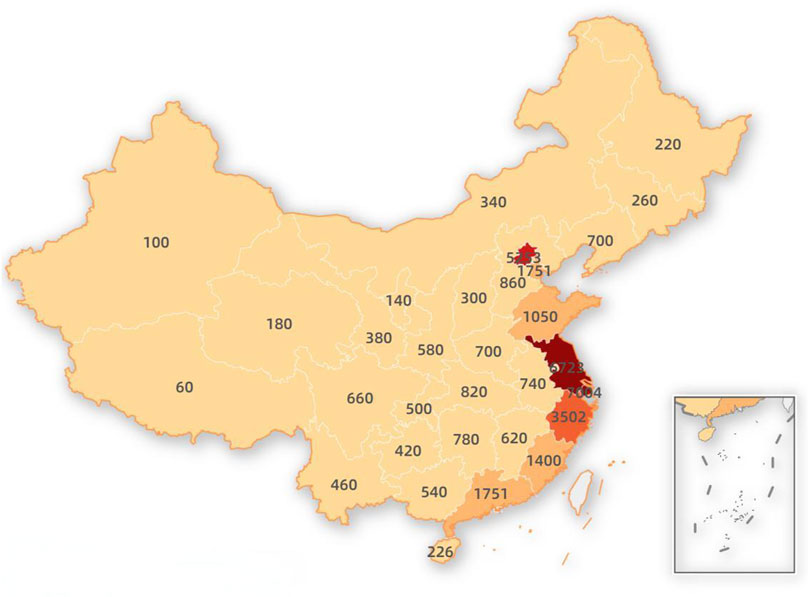- 1Marxist College, Jiangnan University, Wuxi, Jiangsu, China
- 2School of Philosophy and Social Development, South China Normal University, Guangzhou, Guangdong, China
- 3School of Business, Jiangnan University, Wuxi, Jiangsu, China
- 4Grand Canal Culture Research Institute, Jiangnan University, Wuxi, Jiangsu, China
- 5Zhijiang College, Zhejiang University of Technology, Shaoxing, Zhejiang, China
This study investigates the dissemination of major waste sorting policies and public feedback attitudes across 46 key Chinese cities using data from the Weibo social media platform. The research employs a Latent Dirichlet Allocation (LDA) topic model to identify and mine themes from comment texts, extracting multiple core discussion topics. The results show that although negative sentiments slightly outweighed positive sentiments in public comments, there was no significant difference in the focal points of attention between positive and negative sentiments. Negative sentiments primarily centered on policy specifics and implementation methods, with key concerns including details of policy execution and operational challenges. Cities such as Shanghai, Beijing, Nanjing, and Hangzhou exhibited higher volumes of policy-related discussions, indicating greater public engagement in these regions. Analysis of IP address distribution revealed pronounced regional concentration, particularly among residents in developed eastern coastal areas. Finally, the study proposes strategic recommendations for optimizing information dissemination on social media to enhance public willingness to participate in waste sorting initiatives.
Highlights
The study covers the waste sorting policies in 46 key cities across China, with data collected through the Sina Weibo platform, providing representative public feedback.
Utilizing text mining techniques, including sentiment analysis and the LDA model, the study conducts an in-depth analysis of public comments, uncovering the public’s cognition and attitudes towards waste sorting policies.
The study identifies specific reasons for the public’s dissatisfaction with waste sorting policies, providing policymakers with precious insights to improve policy design, optimize promotional strategies, and enhance public participation.
The article highlights the regional concentration of waste sorting policy discussions, particularly the high level of resident engagement in the developed eastern coastal areas, offering a reference for policy dissemination.
1 Introduction
As the pace of global urbanization accelerates and the demand for environmental protection increases, the issue of waste management in China has become increasingly severe. Waste sorting has emerged as one of the crucial measures to alleviate the pressure of urban waste disposal (Zhang et al., 2010). However, despite the implementation of waste sorting policies by local governments across China in recent years, the actual outcomes have not been entirely satisfactory, with a persistently low rate of active participation among residents. Confronted with this challenge, effectively promoting public participation in waste sorting has become a focal point for policymakers and researchers. The rapid development of the internet and social media, particularly the widespread use of platforms such as Weibo, WeChat, and Douyin, has provided a new pathway to address this issue (Wu and Zhang, 2023). These platforms not only have the advantage of disseminating policy information but also facilitate public interaction, enhancing the awareness and action of waste sorting.
The policy of waste sorting originated from the environmental governance experience of developed countries. Since the mid-20th century, countries such as Europe and Japan have been the first to implement systematic waste sorting and recycling mechanisms, which have achieved significant results (Hara and Yabar, 2012). The successful experiences of these countries indicate that waste sorting can significantly reduce the environmental burden of waste disposal and effectively recycle resources, promoting the development of the green economy. However, the implementation of waste sorting largely depends on the cooperation and participation of the public (Yang et al., 2021). Therefore, how to enhance the public’s environmental awareness and actual participation rate has become the key to the success of the policy.
In China, the implementation of waste sorting policies came relatively late, with the government only officially launching a comprehensive waste sorting system in 2017. This plan was issued by the National Development and Reform Commission (NDRC) and the Ministry of Housing and Urban-Rural Development, requiring the 46 key cities to essentially establish a legal framework and infrastructure for waste sorting by 2020 (Table 1).
According to the plan of China’s Ministry of Housing and Urban-Rural Development, by 2025, the waste sorting coverage rate in all cities across the nation will reach 100%, encompassing the waste sorting and disposal systems in urban residential communities (Xinhua News Agency, 2023). These policies signify a significant step forward for China in waste sorting and solid waste management, aiming to enhance resource utilization rates through recycling and sorted disposal, and to reduce environmental impact. Despite the initiation of these policies, the implementation of waste sorting remains less than ideal due to reasons such as weak environmental awareness among residents and incomplete supporting facilities (Zhang D. et al., 2024). There exists substantial societal opposition to waste sorting policies, while formal resource recyclers and non-governmental organizations (NGOs) demonstrate limited operational capacity (Guo and Chen, 2022). Against this backdrop, researching how to leverage emerging technological means—particularly the internet and social media—to promote the implementation of waste sorting policies has become an important topic in current environmental governance studies (Chen et al., 2023).
The advancement of the internet, particularly the prevalence of social media, has significantly altered the modalities through which the public accesses information and engages in social affairs. Platforms such as Weibo, WeChat, and Douyin have introduced novel channels for the dissemination of policies. Utilizing these platforms, the government is capable of rapidly and extensively conveying policy-related information to the public and gaining insights into public feedback through interactive mechanisms. Furthermore, social media offers a venue for the public to articulate opinions and share experiences, thereby transcending waste sorting from a mere level of policy promotion to an ingrained behavioral norm in the daily lives of the populace (Xu et al., 2023). The integration of a “top-down” policy promotion model with a “bottom-up” public feedback mechanism has significantly enhanced the enforceability of policies and the enthusiasm of the public for participation.
In recent years, an increasing number of studies have demonstrated that the role of social media in the promotion of environmental policies cannot be overlooked. Environmental information disseminated through online networks significantly enhances public environmental awareness and policy acceptance. In the implementation of waste sorting policies, social media serves not only as a tool for information dissemination but also as a crucial bridge between the public and the government. Internet usage has a significant positive impact on the willingness of rural households to engage in waste sorting. After accounting for individual choice biases, this result remains robust, with mobile internet emerging as the primary channel for promoting waste sorting. Research indicates that internet usage influences residents’ willingness to sort household waste; residents who use the internet are more inclined to engage in waste sorting than those who do not. Compared to computer usage, the impact of mobile internet usage on the willingness to sort waste is even more pronounced (Wang et al., 2024). Discussions, interactions, and sharing behaviors on social media platforms have gradually turned waste sorting into a topic of widespread public concern.
Traditional policy evaluation and public opinion research often rely on methods such as surveys and interviews. While these methods can provide reference data, they often suffer from issues like small sample sizes and lagging information. In contrast, social media platforms offer a vast amount of data that is real-time and comes from a wide range of sources, encompassing users of different ages, professions, and regions. This makes the use of social media data for policy evaluation and public opinion research an important and valuable tool (Adams-Cohen, 2020). For instance, Weibo, as one of the primary social media platforms in China, boasts a substantial user base. The behaviors and interactions of users on this platform can reflect the public’s cognition and emotional changes regarding waste sorting policies (Liu and Zhou, 2011).
The application of text mining technologies has made the analysis of large-scale social media data feasible. By automating the analysis of waste sorting-related content on platforms such as Weibo, WeChat, and Douyin, researchers are able to uncover the genuine attitudes, emotional inclinations, and behavioral intentions of the public towards policies (Irfan et al., 2015). Specifically, through sentiment analysis, it is possible to identify public support and opposition sentiments towards waste sorting policies, as well as how these emotions evolve over time. This provides a deeper insight into the public’s concerns and doubts. Such information is of great significance for refining policy design, optimizing promotional strategies, and enhancing public participation.
2 Literature review
Social media has emerged as a critical instrument for the dissemination of policies, particularly within the domain of environmental governance. Governmental entities should harness the potential of social media platforms such as Weibo to enhance the propagation of environmental policies, augment public engagement with policy issues, and intensify involvement in environmental management efforts. The content of policy dissemination ought to prioritize the welfare interests of the populace. Utilizing a public discourse system that is accessible and comprehensible is essential to reinforce the interaction between the public and policy content, and to motivate a diverse array of societal actors to participate in the dissemination of policies (Gong et al., 2022). Numerous studies investigating government social media use for crisis communication have predominantly focused on popular platforms such as Twitter and Facebook (Ahmed and Rasul, 2023). Text analysis, as an effective research method, enables a deep understanding of public sentiment and attitudes reflected in social media data. Various Deep Learning (DL) methods have developed rapidly, and they have proven to be successful in many fields such as audio, image, and natural language processing (Peng et al., 2022).
2.1 Study on the Public’s attitude towards waste sorting
Research on public attitudes toward waste sorting has gradually become a focal point in the field of environmental management. Utilizing social media platform data, Huang et al. analyzed public perceptions of waste sorting and found that while discussions predominantly exhibited positive sentiments, negative attitudes emerged regarding specific policy implementation challenges, such as ambiguous classification guidelines, time-consuming procedures, and inadequate regulatory oversight. Additionally, their study revealed divergent concerns across city types: key cities prioritized rural waste sorting fee structures, whereas developed cities focused more on residential environmental impacts (Huang et al., 2023). Through sentiment analysis, Sun et al. demonstrated that public dissatisfaction primarily stems from unclear sorting rules, inconveniences caused by mandatory use of specialized waste bags, and insufficient supporting infrastructure (Sun et al., 2023). The heightened public attention to environmental hazards of plastic pollution reflects rising environmental consciousness, yet practical participation remains constrained by infrastructural deficiencies. Zhang et al. further identified education level and income as critical determinants of waste sorting compliance, with highly educated groups showing stronger adherence to sorting protocols (Zhang Z. et al., 2024). Residents’ positive attitudes contribute to the successful implementation of waste sorting initiatives. Subjective norms and perceived behavioral control indirectly influence behavioral intentions and actual behaviors through the mediation of attitudes (Liu et al., 2023). Despite broad public acceptance and enthusiasm for waste sorting, persistent implementation barriers—including rule ambiguity, inadequate infrastructure, and accessibility limitations—require systematic optimization to enhance participation rates and satisfaction.
2.2 Research on the online dissemination of environmental policies
Studies on waste sorting policies have shown that social media enhances public engagement and feedback mechanisms, presenting an important opportunity for the modernization of China’s environmental governance capabilities. Social media provides a flexible channel for policy advocacy at all levels of government (Chenghao et al., 2020). At the same time, research has also indicated that the use of the internet can motivate individuals to sort household waste. The willingness of Chinese residents to engage in waste sorting is significantly influenced by their use of the internet via smartphones. The dissemination of waste sorting information through internet media, particularly smartphones, is of great importance (Ma and Zhu, 2021). For the environment issue, the social media agenda of parties is more predictive of the traditional media agenda than vice-versa. These findings underscore how closely different agendas are tied together, but also show that advocacy campaigns may play an important role in both constraining and enabling parties to push their specific agendas (Gilardi et al., 2022). These studies collectively demonstrate that social media effectively enhances public participation in and feedback on waste sorting policies. The use of the internet, particularly smartphones, has significantly increased residents’ willingness to engage in waste sorting, while the agenda-setting function of social media further advances the modernization of environmental governance.
2.3 Research on the interaction between policy and the public
In terms of public feedback, two-way communication and the public’s potential willingness to discuss waste sorting policies create possibilities for environmental construction. Within this context, the government and the public are no longer clearly defined opposing entities but rather a community that needs to fulfill the obligation of waste sorting and co-create a clean and tidy living environment (Li et al., 2023). In the matter of waste sorting, current government new media policy dissemination exhibits multiple trends of interaction. This includes action-based interaction, topic-based interaction, and discourse-based interaction on government new media platforms. The government deepens its interaction with the public at various stages of public policy proposal, formulation, announcement, implementation, and feedback, aiming to enhance understanding and expand participation (Zhemin and Fu, 2020). Since 2015, the term “classification” has begun to emerge in the semantic network. By 2016 and 2017, discussions about “garbage treatment” and “waste sorting” became more prominent than “incineration.” This shift originated from the anti-garbage incineration movement, where the government successfully shifted the focus to “waste sorting.” Official and mainstream media framed waste sorting as a solution to the pollution caused by incineration, and civil actors gradually embraced this perspective. A consensus was formed between the official and civil sectors that waste sorting is beneficial for reducing pollution emissions (Jia and Chenghao, 2020). Social media plays a significant role in shaping public opinion and influencing economic decision-making. Through social media platforms, individuals and groups interact, share information, and engage in discussions, thereby forming collective perspectives on diverse issues (Ausat, 2023). These studies collectively demonstrate that bidirectional interactions and sustained communication between the public and government have fostered a collaborative environmental governance community. This synergy promotes the effective crystallization of public opinion and co-governance of environmental agendas.
Although existing research has emphasized the role of social media in the dissemination of waste sorting policies, the specific mechanisms of impact on public attitudes and feedback require further exploration. Social media plays a significant role in enhancing the communication and feedback loop of waste sorting policies. Through textual analysis methods, it is possible to delve deeper into the public’s cognition and sentiment towards policies, thereby addressing the gaps in current research. By systematically analyzing the content of social media discussions, we can gain a better understanding of how the credibility of information and the effectiveness of communication channels influence public attitudes. Future research should continue to focus on public behavior in the social media environment, exploring how social media can be utilized to optimize policy dissemination and public engagement, thereby providing more effective support for the implementation of waste sorting policies. Future studies should further apply textual analysis techniques to investigate the complexity of these influencing factors, thereby enhancing the effectiveness of policy communication.
3 Innovation and research significance
Despite the research that has explored the application of the internet and social media in environmental policies, studies specifically focusing on waste sorting policies are still relatively scarce, particularly in relation to social media discussions, which await further supplementation. For instance, there is a lack of systematic analysis and empirical research in the existing literature on how to enhance public participation and optimize the dissemination effects of policies through social media. Consequently, this study targets the online dissemination of policies in 46 key Chinese cities with waste sorting initiatives. It involves the collection and analysis of dissemination data on Weibo, including posts, comments, reposts, and likes, to conduct an in-depth textual analysis.
3.1 Innovation of research
(1) Innovation in Data Sources and Research Methods: This study breaks through the limitations of traditional questionnaires and interviews by using web crawling technology to collect a large amount of user comment data on Weibo and employs text mining techniques for analysis. This approach provides a more comprehensive and objective reflection of the public’s real attitudes and emotional tendencies towards waste sorting policies. The study uses the LDA topic model for thematic analysis of the text data, revealing hot topics of public concern, such as “garbage bins,” “fines,” and “kitchen waste,” offering policymakers a deeper understanding.
(2) Innovation in Research Perspective: The study focuses on the public’s feedback attitudes towards policies. Through the analysis of public attitudes, it provides a basis for policymakers to improve policies. The study also reveals regional differences in public discussions, with higher participation in eastern coastal developed areas and lower participation in central and western regions, offering references for the formulation of more targeted local policies.
(3) Implications for Policy Making: The study finds that the public’s negative emotions towards waste sorting policies mainly focus on the details of policy implementation and execution processes, such as considerations of time and convenience. This provides policymakers with directions for improvement, such as optimizing the timing and locations of waste sorting and enhancing the training of waste sorting personnel. Additionally, the lack of public knowledge about waste sorting is one of the reasons for negative emotions, suggesting that the government should conduct educational activities on waste sorting knowledge through a combination of online and offline methods.
3.2 Significance of research
(1) Methodological Contribution. By applying big data and text mining techniques to the field of policy research, this study provides new perspectives and methodologies, promoting the scientific and modernization of policy research.
(2) Guidance for Environmental Protection Practice. The research results offer scientific evidence for government departments to optimize the dissemination strategies of waste sorting policies, helping to increase public acceptance and participation in policy implementation and promoting the effective implementation of waste sorting policies.
(3) The study reveals the complexity of the public’s attitudes towards waste sorting policies. Although the public generally supports environmental causes, there are concerns and dissatisfaction with the specific content and execution methods of the policies. This ambivalence provides important insights for policymakers.
The structure of the remaining parts of this paper is as follows. First, a literature review of social media and waste sorting policies is conducted, followed by a detailed description of data collection, processing methods, and text mining. Next, the paper succinctly introduces the public’s focus points, the results of sentiment analysis, and the discussion and analysis of waste sorting policies. Finally, conclusions are drawn, and suggestions for the formulation or improvement of waste sorting policies are proposed.
4 Research methodology
4.1 Data source
The data for this study is sourced from the Weibo social media platform. In the era of big data, web crawling information retrieval technology can intelligently and efficiently collect information, providing assistance for scientific research (Jian and Qin, 2022). The web crawler program is capable of accessing thousands of pages per second, and it includes a high-performance failure manager that can operate independently of the platform or in a platform-dependent manner. Additionally, it can adapt to a variety of configurations without the need for additional hardware. This flexibility and efficiency make the crawler suitable for large-scale data collection tasks in diverse environments (Desai et al., 2017). Through web crawling technology, public interaction and feedback information regarding urban waste sorting policies on Chinese internet platforms can be collected. Web crawlers are generally divided into four types based on differences in target objects, system architecture, and implementation technology: general-purpose web crawlers, focused web crawlers, incremental web crawlers, and deep web crawlers. This paper mainly employs focused web crawler technology to collect the required information. Focused web crawler technology is a type of web crawler designed for specific subject demands, and it filters content during the crawling process, attempting to only collect relevant information from web pages (Akbari Torkestani, 2012). Hence, this paper employs the focused web crawling method. During data crawling, comments were collected based on Weibo posts that explicitly mentioned policy/regulation names (Table 1). Data were collected from Weibo comments from June 2019 to October 2024, yielding a total of 56,841 comments. The implementation principle and workflow are as follows.
To search for the target theme focusing on the main policies of 46 key cities in China for waste sorting, a web crawler program was designed, including functions such as topic identification, content filtering, and link tracking. The program collects the content of each blog post, comments, likes, forwards, as well as information of registered and verified users (such as username, region), etc. The web crawler is written in Python 3.9 programming language to implement the functions of a focused web crawler, collect information, and export it to an Excel file.
The study employs the DrissionPage module as an automated web page interaction tool. The process involves the following steps:
4.1.1 Keyword search and pagination
A loop traversal method is used to search for each keyword in sequence.
The browser’s built-in functions are utilized to perform pagination, ensuring comprehensive coverage of relevant content.
4.1.2 Article link extraction and storage
During the traversal process, the article links from each page of search results are extracted and stored in a file named detail_href for subsequent access.
4.1.3 Article link reading
The stored article links are read from the detail_href file to prepare for individual article content access.
4.1.4 Article access
The browser accesses each article link read from the file to obtain the required information.
4.1.5 Article information scraping and storage
While accessing the articles in the browser, key information such as article content, like counts, and comment numbers are scraped and stored in a detail_json file for data analysis.
4.1.6 Article information reading
The stored article information is read from the detail_json file to provide data support for subsequent comment scraping.
4.1.7 Revisiting articles
Based on the read article information, the browser revisits the article pages one by one.
4.1.8 Comment acquisition
Browser operations are used to scroll down the page and click the “More” button to trigger the loading of all comments, thus completing the capture of comment data.
This systematic approach ensures that the web crawler efficiently collects and stores the necessary data for analysis, focusing on the interaction and feedback related to urban waste sorting policies.
4.2 Text mining analysis
Social media provides a new data source for investigating community opinions on a specific subject or event (Sun et al., 2020). The combination of text mining and web crawling technologies for the collection and processing of unstructured data is more objective and efficient than the traditional methods used in social science research (Wang et al., 2019). Therefore, this paper employs sentiment analysis to dissect the public’s attitudes towards waste sorting. Unsupervised sentiment analysis primarily combines sentiment dictionaries and semantic rules to determine sentiment polarity. This method generally operates at the sentence level and is suitable for fine-grained short texts. It offers a short analysis time and generally produces accurate results. Since Weibo posts are short texts, this paper opts for unsupervised sentiment analysis (Huang et al., 2015). This investigation utilizes the SnowNLP module to conduct sentiment analysis on each comment. SnowNLP has been tailored for Chinese language corpora, particularly excelling in the realm of sentiment analysis, where it demonstrates a superior understanding of Chinese semantics and emotional expression. SnowNLP incorporates a sentiment analysis model based on the Naive Bayes classifier, which has been trained on a substantial dataset of Chinese sentiment data, including both positive and negative reviews. This model is immediately applicable, and sentiment scores can be rapidly obtained either by using the model as-is or by training with one’s own annotated data. The study employs a stop words list to filter out semantically insignificant words. The jieba toolkit is used for the segmentation of each comment into words. The study iterates through the segmentation outcomes, examining each word against the stop words list and excluding it if present, while also tallying the occurrence of each word and sorting them by frequency in descending order. Through this process, the sentiment analysis and word frequency statistical analysis of the comments are completed. After a thorough text preprocessing of the comment content, a total of 35,021 pieces of comment data were consolidated from the 56,841 comments retrieved, with sentiment scores ranging from 0 to 1, where a score closer to one indicates a more positive sentiment.
4.3 Latent Dirichlet Allocation Model
Latent Dirichlet Allocation Model employs unsupervised learning to generate “document-topic” and “topic-word” probability distributions, thereby identifying latent thematic information within large collections of documents (Tang and Xiang, 2014). LDA not only possesses excellent data dimensionality reduction capabilities but also has good model scalability, and it has been widely applied in the field of natural language processing (Yang et al., 2020). The application of LDA in text sentiment classification was thoroughly evaluated, and it was found to perform well in alleviating the issues of high-dimensional feature space and feature sparsity, significantly improving the classification results (Onan et al., 2016).
This paper employs the Python programming language and the LDA algorithm to conduct topic modeling on textual data, and visualizes the analysis results for intuitive presentation. Table 2 displays the probability distribution of the main topic keywords, with the public’s most concerns focusing on “garbage bins” and “fines”. Some topics (such as Topic_3 and Topic_4) concentrate on the practices of specific cities and communities, while other topics (such as Topic_5 and Topic_6) are more focused on the enhancement of environmental awareness. The study also conducts a detailed of the frequency of topic words (Figure 1), presenting the distribution of different topics within the overall data, which provides strong support for further understanding and mining of the textual content. This objectively reflects the naturally emerging focus of public discussions. Such quantitative visualization of keyword weights provides data-driven evidence of public cognition for formulating subsequent policy recommendations.
5 Results and discussion
This study meticulously collected and analyzed the dissemination of key policies on waste sorting from 46 pilot cities in China on the Weibo platform. The research focused on the comment sections of popular Weibo posts, which were identified based on their high ranking resulting from interactive metrics such as likes, views, comments, and retweets, indicative of significant public engagement and open discourse. Utilizing Weibo’s “Settings” feature, we precisely pinpointed these trending posts.
5.1 Sentiment orientation analysis
After conducting a sentiment analysis on the comment data gathered from Weibo, this study employed the NLPIR-Parser platform for in-depth exploration. Following meticulous text preprocessing and the removal of trivial vocabulary, the results revealed (Table 3) that there were a total of 15,133 comments expressing positive sentiments, accounting for approximately 43.21% of the total comments, while 17,074 comments expressed negative sentiments, making up about 48.75% of the total. Negative comments exceeded positive comments by approximately 5.54 percentage points. The remaining approximately 8.31% consists of comments with undetermined or unrecognized sentiments. These comments primarily consist of ambiguous statements, emoji-based interactions, or extremely brief responses.
5.2 Analysis of emotions and policy support
Upon conducting an in-depth analysis of the data, it was found that there is no significant difference in the focus of positive and negative emotions. Examining the structure of the grouped data, one can observe the counts of positive (pos) and negative (neg) emotions associated with different thematic categories. Utilizing these data, an unstacked pivot table was created to compare the distribution of positive and negative emotions across various themes. Figure 2 illustrates the standardized distribution results. From these data, it can be observed that the distribution of positive and negative emotions across different thematic categories is relatively uniform, with no pronounced discrepancies.
This study further examines the content of blog posts within the dataset that pertain to positive and negative emotions, seeking the usage of key terms, extracting these keywords, and comparing their frequency of occurrence in both positive and negative emotional contexts. By comparing the key terms associated with positive and negative emotions, it can be observed that there is a certain degree of overlap in the usage of keywords between the two (Table 4). These keywords appear frequently in both emotional contexts, indicating common concerns among the public with differing attitudes. To address the issue of overlapping positive and negative sentiment keywords in the sentiment analysis results, this study further conducted co-occurrence mining analysis on reduplicated words (e.g., “hahaha,” “haha”) found in the comments. Specifically, advanced co-occurring vocabulary following these reduplicated words was extracted, and the emotional relationships and contextual meanings of these terms were analyzed to explore potential sarcastic usage in both sentiment categories. The findings revealed that co-occurring words associated with the high-frequency reduplicated “ha” exhibited distinct emotional correlations. The contextual usage of reduplicated words demonstrated significant diversity, potentially expressing positive encouragement, public controversy, or neutral teasing sentiments, depending on their subsequent co-occurring terms and expressive contexts (Figure 3). The likely reason for this phenomenon is that the public holds a supportive stance towards environmental protection causes, yet there are some disagreements with the content and implementation of the policies (Table 5).
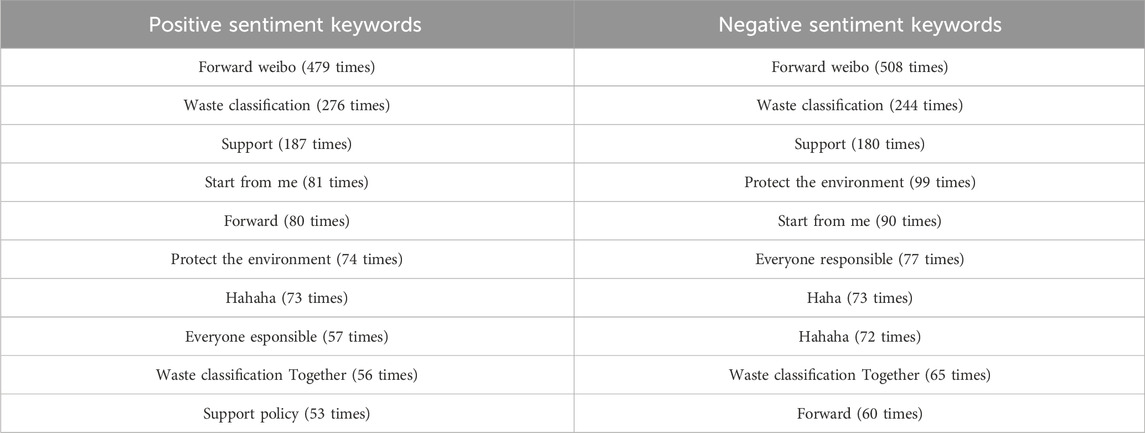
Table 4. The ten most common keywords in positive and negative emotions and their frequency of occurrence.
Through the analysis of keywords and context in negative sentiment blog posts, we can summarize the reasons for the public’s negative attitude towards garbage classification. We identified and extracted frequently occurring keywords from negative sentiment blog posts. Subsequently, we calculated the frequency of these keywords in negative sentiment blog posts to measure the impact of various reasons on public sentiment. The following are the keywords related to each reason and their frequency of occurrence in negative sentiment blog posts (Figure 4), focusing on seven aspects:
Implementation Details and Execution Issues: Many negative comments focus on the implementation details and execution issues of the garbage classification policy. Some blog posts mention problems such as inappropriate placement of garbage sorting points and littering of garbage bags.
Time and Convenience Issues: Some blog posts mention that garbage classification restricts the time for waste disposal, which inconveniences the public who need to dispose of garbage outside of peak commuting hours on weekdays.
Divergent Views on the Policy: There is a divergence in the public’s views on the garbage classification policy. Some blog posts express skepticism about the garbage classification policy, arguing that there is no need to completely emulate the timed waste disposal practices of foreign countries.
Discontent with Non-compliance: The public expresses discontent with behaviors that do not comply with garbage classification regulations. For example, some blog posts mention neighbors or upstairs tenants not sorting or improperly discarding garbage bags, which may exacerbate public dissatisfaction.
Lack of Knowledge on Garbage Classification: Some blog posts refer to confusion over garbage classification standards, reflecting the public’s lack of knowledge about garbage classification and the need for more guidance and publicity.
Change in Personal Habits: Garbage classification requires the public to change long-standing living habits, which may take some time and an adaptation process, leading to a negative attitude from some members of the public.
Skepticism about Policy Effectiveness: Some blog posts express skepticism about the effectiveness of the garbage classification policy, questioning whether it can truly solve environmental problems and suggesting that its impact remains to be seen.
5.3 Analysis of attention across different cities
In the discussions regarding garbage classification policies, different cities have shown varying levels of participation enthusiasm (Figure 5). First and foremost, Shanghai tops the list with 12,007 comments, demonstrating the residents’ high level of attention to garbage classification policies and an active discussion atmosphere. This may be related to the strict implementation of Shanghai’s Domestic Waste Management Regulations and its close connection to residents’ daily lives. Beijing follows closely with 10,517 comments, also reflecting a strong interest in the topic of garbage classification among its residents. Nanjing, Chengdu, and Hangzhou are next in line with 2,525, 2,053, and 970 comments, respectively. The participation of residents in these cities in the discussion of garbage classification policies is relatively lower, but still shows a certain level of attention.
According to statistical analysis of the data, the distribution of IP addresses also shows clear regional concentration (Figures 6, 7). Specifically, IP addresses from Shanghai appear most frequently, followed by Beijing, Jiangsu, and Zhejiang. These data reflect the significant advantage of the eastern developed regions in internet usage and also indicate that internet activities are still widely distributed across the country. In terms of the heat of discussion on garbage classification policies, the participation of cities in central and western China is relatively low. Overall, there is considerable room for improvement in the discussion of garbage classification policies in central and western cities, which also suggests that policymakers and environmental promoters need to increase their efforts in these areas to encourage nationwide participation in garbage classification.
6 Conclusions and recommendations
The study on the internet dissemination effect of waste sorting policies holds significant importance. This research conducted an in-depth analysis of the online dissemination of major waste sorting policies in 46 key cities in China. Specifically, we collected public comment data on household waste sorting policies through the platform of Sina Weibo and utilized text mining techniques to explore residents’ attitudes towards these policies. The main conclusions of the study are summarized as follows: (1) Negative public sentiment is prominent in policy comments, indicating the presence of factors leading to public dissatisfaction in the dissemination and implementation of waste sorting policies. (2) Although there is no significant difference between positive and negative sentiments in terms of focus, it is evident that the public generally supports environmental protection initiatives. Negative emotions are directed towards specific content and implementation methods of the policies, with some dissenting opinions expressed by the public. (3) The main reasons for public negative sentiment can be attributed to several aspects: firstly, issues with policy implementation details and the execution process, such as considerations of time and convenience; secondly, differing views on policy content; thirdly, dissatisfaction with non-compliance behaviors; additionally, the lack of waste sorting knowledge and the difficulty of changing personal habits are also significant factors contributing to negative sentiment. (4) In the discussions on waste sorting policies, cities like Shanghai, Beijing, Nanjing, Chengdu, and Hangzhou have a higher number of comments, reflecting their active participation in policy discussions. Moreover, the distribution of IP addresses shows a clear regional concentration, particularly in the eastern coastal developed areas, indicating a higher level of resident engagement and a more fervent focus on waste sorting policies in these regions.
This study, through textual analysis of waste sorting policy dissemination across 46 key Chinese cities, reveals that while most citizens conceptually support waste sorting, implementation deficiencies—particularly insufficient policy refinement—undermine behavioral compliance. To bridge the “concept-practice” gap, we propose human-centric implementation pathways across three dimensions: institutional design, communication strategies, and educational paradigms. (1) Embed Flexible Governance and Dynamic Adjustment Mechanisms in Policy Design. Maintain unified classification standards while establishing adaptive implementation frameworks. Integrate public deliberation into policy iteration cycles through a “proposal-hearing-feedback” workflow for regulatory revisions. (2) Develop Stratified Communication Narratives and Precision Targeting Systems. Move beyond unidirectional policy advocacy. For younger demographics, employ short videos depicting daily-life scenarios; for older residents, enhance operational clarity via community bulletin boards using “sorting flowcharts + common mistake case studies”. (3) Cultivate Civic Participation Networks. Implement school-based sorting practicums to facilitate youth-led family education. Establish intergenerational learning communities by mobilizing senior sorting experts for peer mentoring within neighborhoods. (4) Promote Regional Coordination through Gradual Scaling and Knowledge Transfer. In eastern metropolises like Shanghai, advance smart infrastructure integration (e.g., the “Green Account” point system). For central/western cities, prioritize baseline infrastructure while adopting eastern management models via city-pairing mechanisms, avoiding resource misallocation from technological overreach.
This study contributes to both the academic and practical realms. Academically, the research provides a new perspective and methodology for the policy research field by utilizing big data and text mining techniques. Practically, the findings offer a scientific basis for government departments to optimize the dissemination strategies of waste sorting policies, which can help increase public acceptance and participation, and promote the effective implementation of these policies. Furthermore, the study reveals regional differences in public discussions, providing a reference for the development of more targeted local policies, and achieving an effective integration of academic research with social practice.
7 Methodological limitations
The study also has its limitations. Firstly, data collection was mainly confined to the Sina Weibo platform, which may not have fully covered public discussions on other social media or online forums. Secondly, the research did not consider the impact of cultural and economic development level differences between cities on the dissemination effect of waste sorting policies. Future research is advised to overcome these limitations.
Data availability statement
The original contributions presented in the study are included in the article/supplementary material, further inquiries can be directed to the corresponding author.
Author contributions
LC: Data curation, Software, Writing – original draft, Writing – review and editing. LH: Software, Writing – original draft, Writing – review and editing. WM: Writing – original draft, Writing – review and editing. SM: Writing – review and editing, Writing – original draft. YL: Investigation, Writing – original draft, Writing – review and editing.
Funding
The author(s) declare that financial support was received for the research and/or publication of this article. This study was supported by the National Social Science Fund of China under the Special Research Program on Major Historical Issues of the Chinese Academy of History: Historical Process and Development Models of the Chinese-style Urbanization Path in the Modern Yangtze River Delta Region (23VLS013).
Acknowledgments
We acknowledge all the participants who made this study possible.
Conflict of interest
The authors declare that the research was conducted in the absence of any commercial or financial relationships that could be construed as a potential conflict of interest.
Generative AI statement
The authors declare that no Generative AI was used in the creation of this manuscript.
Publisher’s note
All claims expressed in this article are solely those of the authors and do not necessarily represent those of their affiliated organizations, or those of the publisher, the editors and the reviewers. Any product that may be evaluated in this article, or claim that may be made by its manufacturer, is not guaranteed or endorsed by the publisher.
References
Adams-Cohen, N. J. (2020). Policy change and public opinion: measuring shifting political sentiment with social media data. Am. Polit. Res. 48, 612–621. doi:10.1177/1532673x20920263
Ahmed, S., and Rasul, M. E. (2023). Examining the association between social media fatigue, cognitive ability, narcissism and misinformation sharing: cross-national evidence from eight countries. Sci. Rep. 13, 15416. doi:10.1038/s41598-023-42614-z
Akbari Torkestani, J. (2012). An adaptive focused Web crawling algorithm based on learning automata. Appl. Intell. 37, 586–601. doi:10.1007/s10489-012-0351-2
Ausat, A. M. A. (2023). The role of social media in shaping public opinion and its influence on economic decisions. Technol. Soc. Perspect. (TACIT) 1, 35–44. doi:10.61100/tacit.v1i1.37
Chen, R., Fan, R., Wang, D., and Yao, Q. (2023). Exploring the coevolution of residents and recyclers in household solid waste recycling: evolutionary dynamics on a two-layer heterogeneous social network. Waste Manag. 157, 279–289. doi:10.1016/j.wasman.2022.12.030
Chenghao, J., Jia, D., and Zeng, F. (2020). Differences in environmental advocacy: a study on the differentiation of government WeChat communication strategies for garbage classification policy. Journal. Q., 97–110. doi:10.1016/j.resconrec.2023.107233
Desai, K., Devulapalli, V., Agrawal, S., Kathiria, P., and Patel, A. (2017). Web crawler: review of different types of web crawler, its issues, applications and research opportunities. Int. J. Adv. Res. Comput. Sci. 1199–1202. doi:10.26483/ijarcs.v8i3.3190
Gilardi, F., Gessler, T., Kubli, M., and Müller, S. (2022). Social media and political agenda setting. Polit. Commun. 39, 39–60. doi:10.1080/10584609.2021.1910390
Gong, P., Wang, L., Liu, X., and Wei, Y. (2022). The value of social media tool for monitoring and evaluating environment policy communication: a case study of the “Zero-waste City” initiative in China. Energy, Ecol. Environ. 7, 614–629. doi:10.1007/s40974-022-00251-8
Guo, S., and Chen, L. (2022). Why is China struggling with waste classification? A stakeholder theory perspective. Resour. Conservation Recycl. 183, 106312. doi:10.1016/j.resconrec.2022.106312
Hara, K., and Yabar, H. (2012). 'Historical evolution and development of waste management and recycling systems—analysis of Japan's experiences. J. Environ. Stud. Sci. 2, 296–307. doi:10.1007/s13412-012-0094-8
Huang, H., Long, R., Chen, H., Sun, K., Sun, Q., and Li, Q. (2023). 'Examining public attitudes and perceptions of waste sorting in China through an urban heterogeneity lens: a social media analysis. Resour. Conservation Recycl. 199, 107233. doi:10.1016/j.resconrec.2023.107233
Huang, Z., Zhao, Z., Liu, Q., and Wang, Z. (2015). An unsupervised method for short-text sentiment analysis based on analysis of massive data, in Intelligent computation in big data era: international conference of young computer scientists, engineers and educators, ICYCSEE 2015. Harbin, China, January 10–12, 2015 (Springer), 169–176.
Irfan, R., King, C. K., Grages, D., Ewen, S., Khan, S. U., Madani, S. A., et al. (2015). A survey on text mining in social networks. Knowl. Eng. Rev. 30, 157–170. doi:10.1017/s0269888914000277
Jia, D., and Chenghao, J. (2020). From democracy and practicality to administrative rationality: weibo's actors and discourse changes in the waste incineration dispute. J. China Geo Univ. Soc. Sci. Ed. 20, 133–146. doi:10.16493/j.cnki.42-1627/c.2020.03.011
Jian, Z., and Qin, L. (2022). The application of big data network crawler technology for architectural culture and environment protection. Concurrency Comput. Pract. Exp. 34, e5769. doi:10.1002/cpe.5769
Li, Z., Sun, W., and Xin, Z. (2023). Research on the new media mobilization path of domestic waste classification policy —— based on the qualitative comparative analysis of Weibo, the government affairs of 27 provincial capitals. News Commun. Rev. 76, 62–76. doi:10.14086/j.cnki.xwycbpl.2023.06.005
Liu, Y., and Zhou, Y. (2011). Social media in China: rising Weibo in government, in 5th IEEE international conference on digital ecosystems and technologies (IEEE DEST 2011). Daejeon, Korea, 31 May–03 June 2011 (IEEE), 213–219.
Liu, Y., Zou, C., Tai, J., and Che, Y. (2023). Evaluation of the household solid waste mandatory sorting policy in Shanghai: A 1-year public opinion survey. Waste Manag. Res. 41, 1305–1317. doi:10.1177/0734242x231155097
Ma, W., and Zhu, Z. (2021). Internet use and willingness to participate in garbage classification: an investigation of Chinese residents. Appl. Econ. Lett. 28, 788–793. doi:10.1080/13504851.2020.1781766
Onan, A., Korukoglu, S., and Bulut, H. (2016). LDA-based topic modelling in text sentiment classification: an empirical analysis. Int. J. Comput. Linguist. Appl. 7, 101–119.
Peng, S., Cao, L., Zhou, Y., Ouyang, Z., Yang, A., Li, X., et al. (2022). A survey on deep learning for textual emotion analysis in social networks. Digital Commun. Netw. 8, 745–762. doi:10.1016/j.dcan.2021.10.003
Sun, Y., Wang, D., Li, X., Chen, Y., and Guo, H. (2023). Public attitudes toward the whole life cycle management of plastics: a text-mining study in China. Sci. Total Environ. 859, 159981. doi:10.1016/j.scitotenv.2022.159981
Sun, Y., Wang, Z., Zhang, B., Zhao, W., Xu, F., Liu, J., et al. (2020). “Residents” sentiments towards electricity price policy: evidence from text mining in social media. Resour. Conservation Recycl. 160, 104903. doi:10.1016/j.resconrec.2020.104903
Tang, X., and Xiang, K. (2014). Hotspot mining based on LDA model and microblog heat. Libr. Inf. Serv. 58, 58–63. doi:10.13266/j.issn.0252-3116.2014.05.010
Wang, X., Liz, M. R. B., Ricardo, F. C. B., Luis, A. M. Q., James, A. P. R., Józef, O., et al. (2024). The role of internet and social interactions in advancing waste sorting behaviors in rural communities. Resources 13, 57. doi:10.3390/resources13040057
Wang, Y., Li, H., and Wu, Z. (2019). Attitude of the Chinese public toward off-site construction: a text mining study. J. Clean. Prod. 238, 117926. doi:10.1016/j.jclepro.2019.117926
Wu, W., and Zhang, M. (2023). Exploring the motivations and obstacles of the public’s garbage classification participation: evidence from Sina Weibo. J. Material Cycles Waste Manag. 25, 2049–2062. doi:10.1007/s10163-023-01659-y
Xinhua News Agency (2023). China to implement garbage sorting in all cities by 2025. Available online at: https://english.www.gov.cn/news/202305/24/content_WS646dd0e9c6d03ffcca6ed564.html.
Xu, D., Chen, Q., Chen, Y., He, J., and Zhang, F. (2023). Sustainable development of rural human settlements in the information age: can internet use drive farmers to participate in garbage classification? Agriculture 13, 846. doi:10.3390/agriculture13040846
Yang, P., Yao, Y., and Zhou, H. (2020). Leveraging global and local topic popularities for LDA-based document clustering. IEEE Access 8, 24734–24745. doi:10.1109/access.2020.2969525
Yang, S., Cheng, P., Wang, S., and Jun, L. (2021). Towards sustainable cities: the spillover effects of waste-sorting policies on sustainable consumption. Int. J. Environ. Res. Public Health 18, 10975. doi:10.3390/ijerph182010975
Zhang, D., Li, J., and Lou, S. (2024). 'Reducing environmental pollution: what affects the waste sorting of Chinese urban residents? The theory of planned behavior with community convenience. J. Material Cycles Waste Manag. 26, 2084–2098. doi:10.1007/s10163-024-01943-5
Zhang, D. Q., Tan, S. K., and Gersberg, R. M. (2010). Municipal solid waste management in China: status, problems and challenges. J. Environ. Manag. 91, 1623–1633. doi:10.1016/j.jenvman.2010.03.012
Zhang, Z., Chen, Z., Zhang, J., Liu, Y., Chen, L., Yang, M., et al. (2024). Municipal solid waste management challenges in developing regions: a comprehensive review and future perspectives for Asia and Africa. Sci. total Environ. 930, 172794. doi:10.1016/j.scitotenv.2024.172794
Keywords: waste sorting, social media, official policy, text analysis, public feedback attitudes, latent dirichlet allocation model
Citation: Chen L, Huang L, Ma W, Ma S and Li Y (2025) The study on the dissemination of waste sorting policies on social media and the public’s feedback attitudes: a text analysis based on comment data of policies in 46 key cities in China. Front. Environ. Sci. 13:1546136. doi: 10.3389/fenvs.2025.1546136
Received: 16 December 2024; Accepted: 08 April 2025;
Published: 06 May 2025.
Edited by:
Jiachao Peng, Wuhan Institute of Technology, ChinaReviewed by:
Feiyu Chen, China University of Mining and Technology, ChinaPhoey Lee Teh, Glyndŵr University, United Kingdom
Copyright © 2025 Chen, Huang, Ma, Ma and Li. This is an open-access article distributed under the terms of the Creative Commons Attribution License (CC BY). The use, distribution or reproduction in other forums is permitted, provided the original author(s) and the copyright owner(s) are credited and that the original publication in this journal is cited, in accordance with accepted academic practice. No use, distribution or reproduction is permitted which does not comply with these terms.
*Correspondence: Wanqi Ma, OTE1NTc5MDUyQHFxLmNvbQ==
 Liangkun Chen
Liangkun Chen Lexin Huang2
Lexin Huang2 Suwei Ma
Suwei Ma